
HOME
INTRO
SYMBOLS
ALMANAC
ECONOMY
GEOGRAPHY
STATE MAPS
PEOPLE
FORUM
NEWS
COOL SCHOOLS
STATE QUIZ
STATE LINKS
BOOK STORE
MARKETPLACE
GUESTBOOK
CONTACT US


You may double left-click on a word on this page to retrieve its definition. Tweet Follow
Georgia State Wild Flower
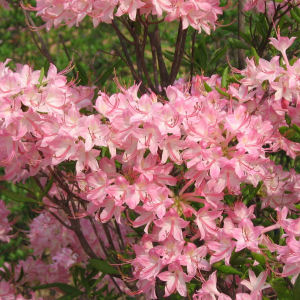
Georgia State Wild Flower: Native Azaleas
Rhododendron canescens
There was a time when Georgia did not have a state flower, much less a state wild flower.
It was way back in 1916, during World War One and before the roaring twenties and the stock market collapse of 1929, before the Great Depression and World War Two, before the Korean Conflict and the Vietnam War, that Georgia adopted its official state floral emblem, the Cherokee rose.
In 1979, the Georgia General Assembly chose to address the issue of a state wildflower. Azaleas, "considered by many to be the most beautiful of indigenous shrubs," were an obvious choice.
House Joint Resolution No. 76 proposed that the many varieties of azalea growing in the state be named "Georgia's state wild flower." The resolution was approved by both houses of the Georgia General Assembly and signed by Governor George Dekle Busbee on April 19, 1979.
Joint Resolution of the Georgia General Assembly
April 19, 1979AZALEA DESIGNATED AS "STATE WILD FLOWER".
No. 76 (House Resolution No.207-803).A RESOLUTION
Designating the azalea as the "State Wild Flower"; and for other purposes.
WHEREAS, although the State of Georgia has designated a "State Flower," she has never had a "State Wild Flower"; and
WHEREAS, those species of azalea which are native to the southeastern United States are considered by many to be the most beautiful of indigenous shrubs; and
WHEREAS, while many species and varieties of the azalea are found across the State of Georgia from the mountains to the sea, several species, including Rhododendron Austrinum, prunifolium, canescens, alabamense, calendulaceum, speciosum, arborescens, serrulatum, and other, are found in every county of the State; and
WHEREAS, the dazzling blossoms of these wild flowers range in color from white to yellow, orange, scarlet, crimson, and intermediate colors, some with conspicuous color blotches; and
>WHEREAS, with proper selection of species, the azalea blossom is available from March until July and August; and
WHEREAS, native azaleas are hardier and, once established, require less care than other horticultural varieties; and
WHEREAS, from Bartram's time until the present, azaleas have covered our State with beauty; and
WHEREAS, it is only fit and proper that the azalea be designated the "State Wild Flower."
NOW, THEREFORE, BE IT RESOLVED BY THE GENERAL ASSEMBLY OF GEORGIA that the azalea is hereby designated as Georgia's "State Wild Flower."
Approved April 19, 1979.
Source: Ga. Laws 1979, pp. 1387-1388.
Though no specific variety is named in the statute, several "native" varieties are named in the nominating joint resolution as appearing in every county of the state. Among them are Rhododendron Austrinum, R. prunifolium, R. canescens, R. alabamense, R. calendulaceum, R. speciosum, R. arborescens, and R. serrulatum.
The azalea served the State of Georgia well for thirty-four years.
But on February 11, 2013, State Representative Debbie Buckner filed House Bill No. 297 to clarify the intention of the original resolution. She was convinced that the earlier resolution intended the "native" azalea to be the recipient of the official wild flower designation and her bill was introduced to ensure that this was understood. *
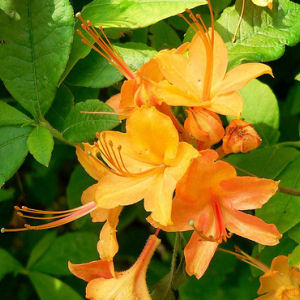
Georgia State Wild Flower: Native Azaleas
Rhododendron calendulaceum
“There’s a difference between the azalea and the native azalea,” she said. Her legislation proposed that "azalea" in the original declaration be replaced by "native azalea."
On February 26, 2013, a substitute version of House Bill No. 338, "relating to the Georgia Council for the Arts, so as to clarify the role of arts in economic development," was passed by a vote of the House of Representatives. It was received in the Georgia Senate on February 27, 2013. But House Bill No. 338 did not even mention azaleas -- at least not at that time.
Several days later, on March 4, 2013, Rep. Bruckner's native azalea bill, House Bill No 297, was passed unanimously by a vote of the Georgia House of Representatives.
There was still a good month before the Wild Azalea festival held each year at the William H. Reynolds Memorial Nature Preserve.
House Bill No. 297 was forwarded to the Senate for consideration with hope for a smooth ride. Unfortunately, it was not to be.
The Senate received House Bill No. 297 on March 5, 2013 and referred it to the Senate Committee on Government Oversight where it seemed destined to remain.
The days passed, turned into weeks, and passed some more. House Bill No. 297 remained stuck in the Senate Committee on Government Oversight.
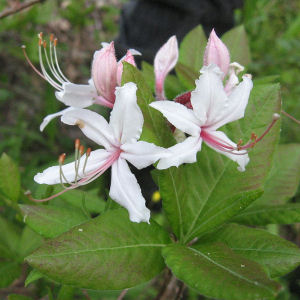
Georgia State Wild Flower: Native Azaleas
Rhododendron periclymenoides
Remember House Bill No. 338?
On March 28, 2013, Senator Joshua McKoon, from the floor of the Senate, put forth an amendment to House Bill No. 338. The proposed amendment, unrelated to the bill's original focus, would add the necessary verbiage to adopt the "native" azaleas as Georgia's official state wild flower.
The amendment was approved and House Bill No. 338, as amended was passed by the Senate on the same day. The House of Representatives followed suit and agreed to the amended bill on the same day.
House Bill No. 338 was sent to Governor John Nathan Deal on April 3, 2013, three days before the Wild Azalea Festival.
Governor Deal held onto the bill for a month before signing it on May 7, 2013. The law declaring "native azaleas" the official wild flowers of the State of Georgia went into effect on July 1, 2013 in plenty of time for the 2014 Wild Azalea Festival.
* The legislation calls for native azaleas, collectively, to be recognized as the Georgia state wild flower. This is because there are many varieties or species, twelve or thirteen, that are considered native to Georgia.
- Georgia Native Azaleas prepared by Earl Sommerville.
- Native Azaleas from the Azalea Society of America.
Georgia Law
The following information was excerpted from the Georgia Code, Title 50, Chapter 3, Article 3, Section 50-3-54.
TITLE 50. STATE GOVERNMENT
CHAPTER 3. STATE FLAG, SEAL, AND OTHER SYMBOLS
ARTICLE 3. OTHER STATE SYMBOLS
O.C.G.A. § 50-3-54 (2014)
§ 50-3-54. State wild flower
The native azaleas (Rhododendron sp.), collectively, are designated as the Georgia state wild flower.
HISTORY: Ga. L. 1979, p. 1387; Ga. L. 2013, p. 1042, § 5/HB 338.
Sources...
Yeomens, Curt. "Annual Azalea Celebration Ready to Bloom." The Clayton Daily News. The Clayton Daily News, 29 Mar. 2013. Web. 13 Sept. 2013.
"Legislative Notebook: Georgia’s State Wildflower Clarified." The Macon Telegraph. The Macon Telegraph, 4 Mar. 2013. Web. 22 Sept. 2013.
"2013-2014 Regular Session - HB 297." Georgia General Assembly. State of Georgia, 31 Dec. 2014. Web. 27 Apr. 2015.
"2013-2014 Regular Session - HB 338." Georgia General Assembly. State of Georgia, 31 Dec. 2014. Web. 27 Apr. 2015.
"Official Code of Georgia." LexisNexis.com. LexisNexis. Web. 27 Apr. 2015.
Shankle, George Earlie. State Names, Flags, Seals, Songs, Birds, Flowers, and Other Symbols. Irvine, Calif.: Reprint Services Corp, Revised edition, 1971.
Shearer, Benjamin F. and Barbara S. State Names, Seals, Flags and Symbols: A Historical Guide Third Edition, Revised and Expanded. Westport, Conn: Greenwood Press, 3 Sub edition, 2001.
Additional Information
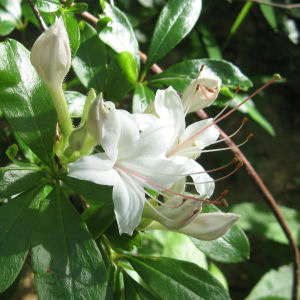
Georgia State Wild Flower: Native Azaleas
Rhododendron arborescens
Gerogia Native Azaleas: Website of Earl Sommerville.
Native Azaleas: The Azalea Society of America.
How to Grow Native Azaleas: Article by Tom Order .
Transplanting Native Azaleas and Their Propagation by Root Cuttings: Journal American Azalea Society:Spring 1979, Volume 33, Number 2 from Virginia Tech Digital Library and Archives.
Georgia Native Plant Society: Official website of the Georgia Native Plant Society.
Rhododendron arborescens ( (Pursh) Torr. (smooth azalea): United States Department of Agriculture: Natural Resources Conservation Service: Plants Database.
Rhododendron atlanticum (Ashe) Rehder (dwarf azalea): United States Department of Agriculture: Natural Resources Conservation Service: Plants Database.
Rhododendron austrinum (Small) Rehder (orange azalea): United States Department of Agriculture: Natural Resources Conservation Service: Plants Database.
Rhododendron calendulaceum (Michx.) Torr. (flame azalea): United States Department of Agriculture: Natural Resources Conservation Service: Plants Database.
Rhododendron canescens (Michx.) Sweet (mountain azalea): United States Department of Agriculture: Natural Resources Conservation Service: Plants Database.
Rhododendron colemanii (Red Hills azalea): Journal of the American Rhododendron Society, Spring 2008.
Rhododendron cumberlandense E.L. Braun (Cumberland rhododendron): United States Department of Agriculture: Natural Resources Conservation Service: Plants Database.
Rhododendron flammeum (Michx.) Sarg. (piedmont azalea): United States Department of Agriculture: Natural Resources Conservation Service: Plants Database.
Rhododendron periclymenoides (Michx.) Shinners (pink azalea): United States Department of Agriculture: Natural Resources Conservation Service: Plants Database.
Rhododendron prinophyllum Small) Millais (early azalea): United States Department of Agriculture: Natural Resources Conservation Service: Plants Database.
Rhododendron prunifolium (Small) Millais (plumleaf azalea): United States Department of Agriculture: Natural Resources Conservation Service: Plants Database.
Rhododendron viscosum (L.) Torr. (swamp azalea): United States Department of Agriculture: Natural Resources Conservation Service: Plants Database.
State wildflowers: Complete list of official state wildflowers from NETSTATE.COM
More symbols & emblems: Complete list of official Georgia state symbols from NETSTATE.COM.
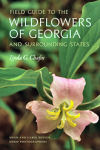
Field Guide to the
Wildflowers of Georgia
and Surrounding States
Linda G. Chafin
Hugh Nourse
Carol Nourse
Field Guide to the Wildflowers of Georgia and Surrounding States, by Linda G. Chafin and Hugh Nourse, Carol Nourse. 528 pages. Publisher: University of Georgia Press (June 1, 2016)
Field Guide to the Wildflowers of Georgia and Surrounding States is the first field guide devoted exclusively to Georgia’s wildflowers, while also including a large number of plants found in neighboring states. Organized in a clear and logical way, Linda G. Chafin’s guide is both scientific and accessible to those who aren’t professional botanists. The guide includes nontechnical species descriptions and comparisons with similar plants, information on the habitats and natural communities that support Georgia’s wildflowers, and suggestions for the best places and times to see wildflowers.
The guide includes descriptions of the wildflowers found in forests, woodlands, and wetlands, as well as those growing along roadsides that are often dismissed as “weeds” but may first attract the attention of budding naturalists.
- A large set of 750 thumbnail photographs that allows users to identify plants by flower color
- Detailed descriptions for 770 of the most common wildflowers found in Georgia and throughout most of the Southeast, as well as additional information for 530 “similar to” species
- Descriptions of the natural communities in Georgia where wildflowers may easily be seen
- An alphabetical arrangement by plant family, with each plant family broken down alphabetically by genus and species
- A guide to the pronunciation of scientific names
- Lightweight and sturdy enough for the field but inclusive enough for the reference shelf
- A guide to the pronunciation of scientific names
- 90% or more of the species in this guide occur in Alabama, North Carolina, and South Carolina
- A guide to the pronunciation of scientific names
- 80% or more of the species in this guide occur in Florida, Louisiana, Mississippi, Tennessee, and Virginia
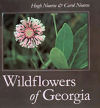
Wildflowers of Georgia
Hugh Nourse
Carol Nourse
Wildflowers of Georgia, by Hugh Nourse and Carol Nourse. 120 pages. Publisher: University of Georgia Press; First Edition (April 14, 2000)
Wildflowers of Georgia showcases the native flowering plants that are on display all throughout Georgia. For eight years, Hugh and Carol Nourse traveled the state, from the Coastal Plain to the Blue Ridge mountains and all points in between, finding and photographing wildflowers in their own habitats and in their best blooming seasons. The 86 vividly detailed photographs presented in this large-format volume capture the diversity and splendor of these sometimes elusive plants, many of which are endangered by human activities.
Each photo is accompanied by a concise caption that provides common and scientific names, place and season photographed, and information on whether the plant is a Georgia protected plant. Armchair naturalists will not have to leave the comfort of their homes to appreciate this photographic collection of many of the state's wildflowers, but readers inspired to undertake their own search for these beauties will find suggestions for hiking trails and other sites to view wildflowers. Anyone who loves Georgia will treasure this book, and wildflower lovers everywhere will appreciate this beautiful depiction of the state's botanical diversity.

Favorite Wildflower
Walks in Georgia
Hugh Nourse
Carol Nourse
Favorite Wildflower Walks in Georgia, by Hugh Nourse and Carol Nourse. 208 pages. Publisher: University of Georgia Press (March 1, 2007)
Wildflower lovers across Georgia know Hugh and Carol Nourse through their popular slide lectures. Countless other enthusiasts have seen their glorious wildflower photographs in books and magazines. Here the Nourses draw on years of travel around the state to share their favorite places for seeing wildflowers. Of the many walks the Nourses have taken, these are the ones they return to most often because of the density or the unusual nature of the floral display. All twenty of these wildflower walks are on public land; everything you need to know about how to find them and what to do once you're there is included.
Five walks are presented from each of Georgia's four geographic regions: Cumberland Plateau/Ridge and Valley (northwestern Georgia); Blue Ridge (northeastern Georgia); Piedmont (Georgia foothills and fall line); and Coastal Plain (all of Georgia below the fall line). For each walk, a scenic photo gives a hint of the locale's overall character. In addition, five of the wildflowers encountered on the walk are profiled with a photograph and a detailed description. All of the wildflowers on these walks are native to Georgia. A few are rare and endangered. Common plant names are used in the main text; the index lists both common and scientific names.
Coverage of each walk includes directions and a trail map plus information about:
- flowering season
- peak flowering period
- flower habitats
- walk length and difficulty
- restroom availability
- applicable fees
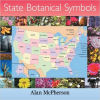
State Botanical Symbols
Alan McPherson
State Botanical Symbols, by Alan McPherson. 132 pages. AuthorHouse (June 10, 2013)
Alan McPherson is a naturalist who resides in northern Indiana and enjoys traveling and learning about the botanical resources our vast country.
In this reference book over 200 state botanical symbols are presented with informative text that highlights their adoptive legislation, botanical and social history. From the white pine of Maine's northeastern forests, westward to the yellow hibiscus of Hawaii's Polynesian islands, our state's official botanical symbols are as uniquely diverse as the terrain and character of the 50 states themselves.
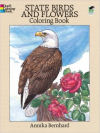
State Birds and Flowers
Coloring Book

U.S. State Flowers
in Counted Cross Stitch
Gerda Bengtsson
State Birds and Flowers Coloring Book
by Annika Bernhard
51 accurately detailed, copyright-free renderings include national bird (eagle) and flower (rose) plus 50 state birds and flowers.
U. S. State Flowers in Cross Stitch
by Gerda Bengtsson - Botanically correct cross stitch designs of state flowers of the 50 States.
Quilting Flowers of the States
by Sue Harvey - A lovely 12-inch flower block for each of the 50 states. Techniques used are piecing, appliqué, paper-piecing and three-dimensional techniques.
Plants, Seeds & Flowers:
Bulbs, seeds, plants, fertilizer, plant containers, garden tools and more.

